The Ceramic and Porcelain Tableware Market is estimated to be valued at USD 7.4 billion in 2025 and is projected to reach USD 11.3 billion by 2035, registering a compound annual growth rate (CAGR) of 4.3% over the forecast period.
The ceramic and porcelain tableware market is growing steadily, supported by evolving lifestyle trends, premiumization in dining aesthetics, and the expansion of the hospitality sector. Rising consumer preference for durable and visually appealing tableware has fueled demand for porcelain and ceramic products across both residential and commercial segments.
The market benefits from continuous design innovation, enhanced glaze technologies, and a resurgence of fine dining culture globally. With e-commerce enabling wider product accessibility, demand for handcrafted and customized pieces has increased, blending tradition with modernity.
Manufacturers are also focusing on sustainable production methods and energy-efficient kilns to align with environmental goals. As consumer spending on home décor and hospitality experiences continues to rise, the market is expected to experience sustained momentum in the coming years.
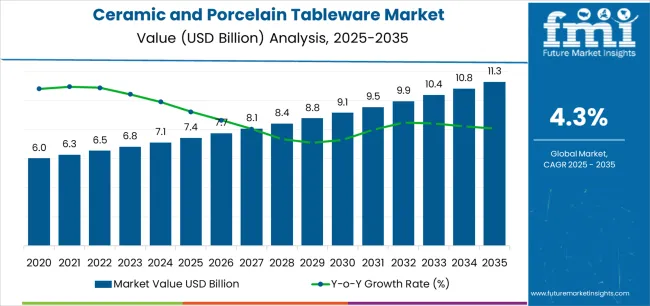
| Metric | Value |
|---|---|
| Ceramic and Porcelain Tableware Market Estimated Value in (2025 E) | USD 7.4 billion |
| Ceramic and Porcelain Tableware Market Forecast Value in (2035 F) | USD 11.3 billion |
| Forecast CAGR (2025 to 2035) | 4.3% |
The market is segmented by Material, Technology, Product, and Distribution Channel and region. By Material, the market is divided into Porcelain, Bone China, Stoneware, and Others. In terms of Technology, the market is classified into Slip Casting, Pressure Casting, Isostatic Casting, and Others. Based on Product, the market is segmented into Dinnerware, Beverage Ware, Cookware, and Others. By Distribution Channel, the market is divided into Supermarket & Hypermarket, Wholesalers & Retailers, and Online. Regionally, the market is classified into North America, Latin America, Western Europe, Eastern Europe, Balkan & Baltic Countries, Russia & Belarus, Central Asia, East Asia, South Asia & Pacific, and the Middle East & Africa.
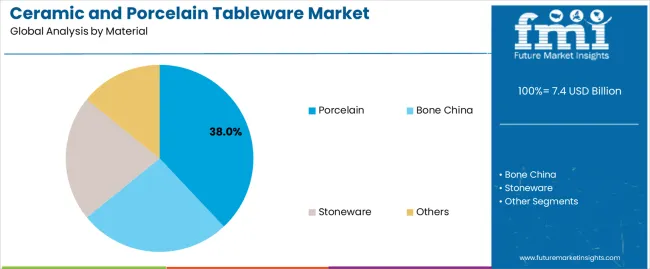
The porcelain segment leads the material category with approximately 38.0% share, driven by its superior translucency, strength, and resistance to thermal shock. Porcelain’s fine composition and elegant finish make it the preferred material in premium dining and hotelware.
Advancements in firing techniques and material refinement have improved durability while preserving aesthetic appeal. The segment’s growth is further supported by increased demand in luxury and hospitality settings, where design consistency and quality are key differentiators.
With rising interest in high-end home dining and artisanal collections, porcelain is expected to maintain its dominance in the global tableware market.
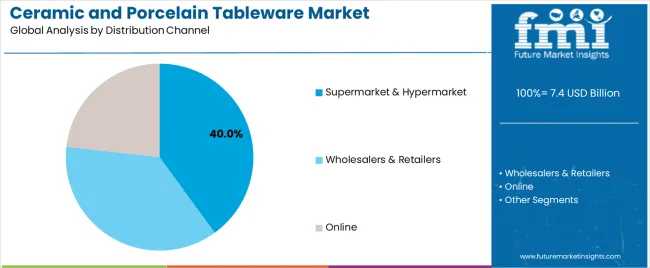
The slip casting segment dominates the technology category, capturing approximately 51.2% share. This technique enables precise shaping of complex and delicate designs, supporting high-quality mass production of tableware.
Slip casting allows for uniform thickness and fine detailing, which are critical for premium products. The segment benefits from advancements in mold materials and automation, improving efficiency and reducing waste.
Its adaptability to both artistic and commercial manufacturing environments enhances its relevance. With the rising global appetite for aesthetically refined and cost-efficient tableware, the slip casting method is projected to remain the industry standard in the coming years.
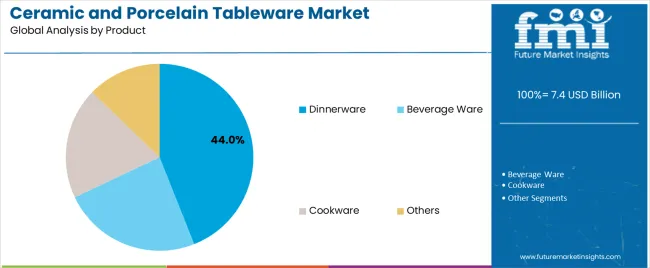
The dinnerware segment holds approximately 44.0% share of the product category, driven by steady household replacement demand and expanding hospitality procurement. As dining presentation becomes increasingly important, consumers and businesses alike are investing in high-quality dinnerware sets that combine design, functionality, and durability.
The segment benefits from seasonal product innovation, branding collaborations, and e-commerce-driven accessibility. Strong replacement cycles and gifting trends further contribute to sustained sales volume.
With the continued growth of restaurants, hotels, and modern households, the dinnerware segment is expected to retain its leadership throughout the forecast period.
The global demand for ceramic and porcelain tableware market was estimated to reach a valuation of USD 6 billion in 2020, according to a report from Future Market Insights (FMI). From 2020 to 2025, sales witnessed significant growth in the ceramic and porcelain tableware market, registering a CAGR of 6.1%.
| Historical CAGR (2020 to 2025) | 6.1% |
|---|---|
| Forecast CAGR (2025 to 2035) | 4.5% |
Cultural heritage has a significant effect on the market for ceramic and porcelain dinnerware, which is often underestimated. Designs for tableware frequently incorporate historical and cultural themes, appealing to customers looking for a sense of authenticity and a link to their past. This feature gives customer preferences and product offers in the market a distinctive twist.
Some important factors that will boost the market growth through 2035 are:
Growing Trend towards Sustainable Living to Push Demand
The market for ceramic and porcelain tableware is also being driven by the rising trend of sustainable living. Customers are looking for eco-friendly tableware solutions created from recycled or renewable materials and produced using sustainable techniques as a result of growing environmental awareness.
Due to the shift in customer tastes, companies are being forced to fulfill market demand for environmentally aware products by investing in sustainable sourcing, production, and packaging techniques. Companies that emphasize eco-friendly efforts stand to gain an advantage in the market as customers increasingly prioritize sustainability.
Increasing Trend towards Fine Dining to bolster Demand Globally
The market for ceramic and porcelain dinnerware is significantly driven by the growing emphasis on fine dining experiences and the aesthetics of home décor. Tableware that improves the dining atmosphere is sought after by consumers that emphasize entertaining and dining at home.
Demand for chic and adaptable dinnerware designs that go well with both formal and informal parties is being driven by this trend. In order to adapt to changing customer tastes and lifestyle trends, manufacturers take advantage of this by providing a broad choice of cutting-edge designs and collections.
Easily Available Alternate Tableware Material to Impede Market Growth
A number of problems are impeding the market expansion for ceramic and porcelain tableware. These include shifts in the economy that have an impact on consumer purchasing, heightened competition from substitute materials like stainless steel and glass, and stricter environmental restrictions.
Further impeding market development are issues like growing production costs, especially for energy and raw materials, and the possibility of counterfeit goods. Manufacturers who are trying to stay competitive face challenges from shifting consumer tastes and lifestyle trends.
This section focuses on providing detailed analysis of two particular market segments for ceramic and porcelain tableware, the dominant material type and the significant technology type. The two main segments discussed below are bone china and slip casting.
| Material Type | Bone China |
|---|---|
| CAGR from 2025 to 2035 | 4.3% |
During the forecast period, the bone china segment is likely to garner a 4.3% CAGR. Tableware made of bone china is anticipated to become more and more popular due to its exceptional blend of durability, elegance, and translucency. With its delicate appearance and outstanding strength, it appeals to consumers looking for beautiful yet practical dinnerware solutions.
Bone china is appropriate for both regular usage and special events due to its resistance to high temperatures. As a result of its classic design and excellent craftsmanship, it is a popular option for discriminating diners who want to upgrade their dining encounters.
| Technology | Slip Casting |
|---|---|
| Market Share in 2025 | 51.2% |
In 2025, the slip casting segment is likely to acquire a 51.2% global market share. Slip casting technique is positioned to gain popularity in the industry due to its versatility and low cost. With this process, complex designs for porcelain and ceramic dinnerware may be produced in large quantities at a reliable level of quality.
Its capacity to effectively construct elaborate features and complicated forms appeals to firms looking for innovative manufacturing methods to satisfy a wide range of customer demands. Slip casting is less expensive to produce than traditional techniques, which makes it a desirable choice for companies looking to streamline operations and maintain their competitiveness.
The markets for ceramic and porcelain tableware in a few significant countries, including the United States, the United Kingdom, China, Japan, and South Korea, will be covered in detail in this section. The section will focus on the primary factors driving up demand for ceramic and porcelain tableware in these countries.
| Countries | Forecast CAGR from 2025 to 2035 |
|---|---|
| The United States | 4.8% |
| The United Kingdom | 5.7% |
| China | 4.9% |
| Japan | 6.1% |
| South Korea | 6.4% |
The United States ceramic and porcelain tableware is anticipated to gain a CAGR of 4.8% through 2035. Factors that are bolstering the growth are:
The market in the United Kingdom is expected to expand with a 5.7% CAGR through 2035. The factors pushing the growth are:
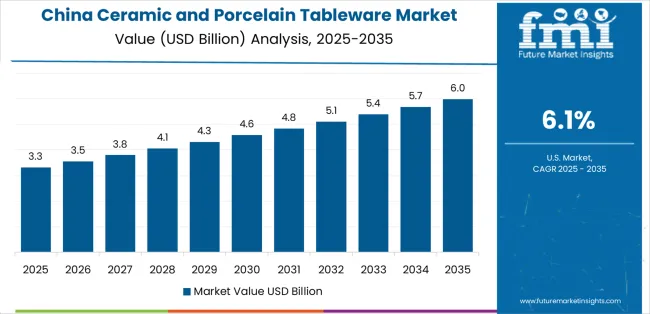
The ceramic and porcelain tableware ecosystem in China is anticipated to develop with a 4.9% CAGR from 2025 to 2035. The drivers behind this growth are:
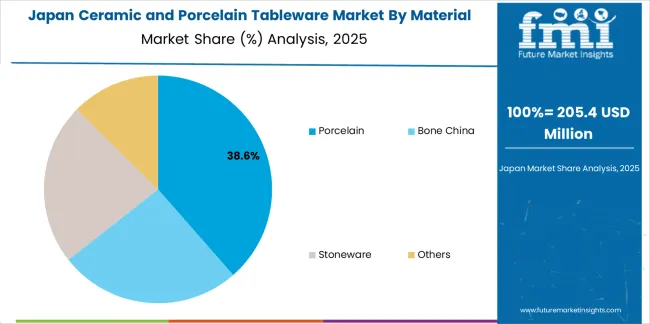
The ceramic and porcelain tableware industry in Japan is anticipated to reach a 6.1% CAGR from 2025 to 2035. The drivers propelling growth forward are:
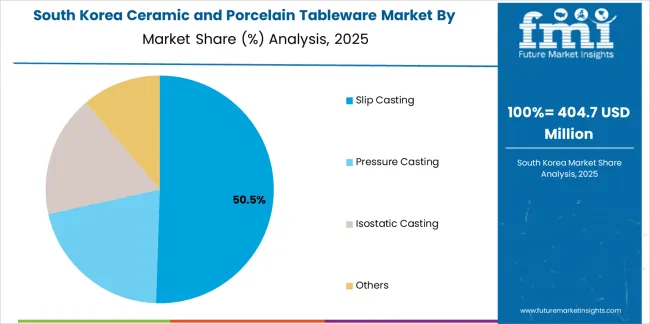
The ceramic and porcelain tableware ecosystem in South Korea is likely to attain a 6.4% CAGR during the forecast period. The factors bolstering the growth are:
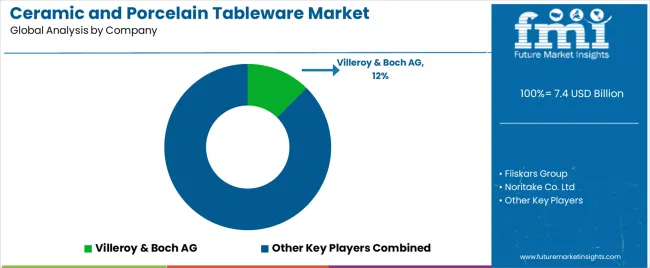
Companies in the global ceramic and porcelain tableware market are employing a range of tactics in an effort to increase profits. They put a lot of effort into creating innovative products, bringing in fresh hues, forms, and patterns to meet changing customer demands.
Companies use e-commerce platforms to reach a wider audience and build strategic alliances with global merchants.
They also spend money on marketing initiatives that raise customer awareness of the brand and increase consumer involvement. Some companies put a high priority on sustainability initiatives, creating eco-friendly tableware to appeal to customers who care about the environment and take advantage of the market's rising demand for sustainable goods.
Significant advancements in the ceramic and porcelain tableware sector are being made by key market participants, and these include:
| Report Attribute | Details |
|---|---|
| Growth Rate | CAGR of 4.5% from 2025 to 2035 |
| Market value in 2025 | USD 7.1 billion |
| Market value in 2035 | USD 11 billion |
| Base Year for Estimation | 2025 |
| Historical Data | 2020 to 2025 |
| Forecast Period | 2025 to 2035 |
| Quantitative Units | USD billion for value |
| Report Coverage | Revenue Forecast, Company Ranking, Competitive Landscape, Growth Factors, Trends, and Pricing Analysis |
| Segments Covered | Material, Technology, Product, Distribution Channel, Region |
| Regions Covered | North America; Latin America; Western Europe; Eastern Europe; South Asia and Pacific; East Asia; The Middle East & Africa |
| Countries Profiled | The United States, Canada, Brazil, Mexico, Germany, The United Kingdom, France, Spain, Italy, Poland, Russia, Czech Republic, Romania, India, Bangladesh, Australia, New Zealand, China, Japan, South Korea, GCC Countries, South Africa, Israel |
| Key Companies Profiled | Villeroy & Boch AG; Fiiskars Group; Noritake Co. Ltd; RAK Ceramics PJSC; Lifetime Brands Inc.; Lenox Corporation; Rosenthal GmbH; Churchill China (UK) Limited; Richard Ginori S.r.l; Tognana Porcellane S.p.A |
| Customization Scope | Available on Request |
The global ceramic and porcelain tableware market is estimated to be valued at USD 7.4 billion in 2025.
The market size for the ceramic and porcelain tableware market is projected to reach USD 11.3 billion by 2035.
The ceramic and porcelain tableware market is expected to grow at a 4.3% CAGR between 2025 and 2035.
The key product types in ceramic and porcelain tableware market are porcelain, bone china, stoneware and others.
In terms of technology, slip casting segment to command 51.2% share in the ceramic and porcelain tableware market in 2025.






Full Research Suite comprises of:
Market outlook & trends analysis
Interviews & case studies
Strategic recommendations
Vendor profiles & capabilities analysis
5-year forecasts
8 regions and 60+ country-level data splits
Market segment data splits
12 months of continuous data updates
DELIVERED AS:
PDF EXCEL ONLINE
Ceramic Textile Market Size and Share Forecast Outlook 2025 to 2035
Ceramic Matrix Composites Market Size and Share Forecast Outlook 2025 to 2035
Ceramic Frit Market Size and Share Forecast Outlook 2025 to 2035
Ceramic Substrates Market Size and Share Forecast Outlook 2025 to 2035
Ceramic 3D Printing Market Size and Share Forecast Outlook 2025 to 2035
Ceramic Injection Molding Market Size and Share Forecast Outlook 2025 to 2035
Ceramic Paper Market Size and Share Forecast Outlook 2025 to 2035
Ceramic Balls Market Size and Share Forecast Outlook 2025 to 2035
Ceramic Tester Market Size and Share Forecast Outlook 2025 to 2035
Ceramic Membranes Market Analysis - Size, Share and Forecast Outlook 2025 to 2035
Ceramic Barbeque Grill Market Analysis - Size, Share, and Forecast Outlook 2025 to 2035
Ceramic Tiles Market Growth & Trends 2025 to 2035
Ceramic Sanitary Ware Market Trends & Forecast 2025 to 2035
Ceramic Transducers Market Growth - Trends & Forecast 2025 to 2035
Leading Providers & Market Share in Ceramic Barbeque Grill Industry
Ceramic Ink Market
Ceramic Coating Market Growth – Trends & Forecast 2024-2034
Ceramic Additives Market
Ceramic Insulator Market
Ceramic Tableware Market Size and Share Forecast Outlook 2025 to 2035

Thank you!
You will receive an email from our Business Development Manager. Please be sure to check your SPAM/JUNK folder too.
Chat With
MaRIA